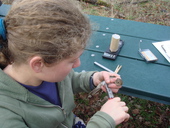Highlight
Do birds spread seeds of potentially invasive trees?
Achievement/Results
Trainee Clare Aslan studied the impact of birds on the spread of non-native trees in the California Central Valley using methods from plant ecology, animal behavior, and social sciences. Some of these trees are known to be invasive in other regions of the US, others have been planted for centuries with no apparent negative impacts upon local ecosystems.
Aslan and faculty member Marcel Rejmanek surveyed 173 ornithologists from four U.S. states, asking them to report observations of bird interactions with nonnative plants. They used respondents’ descriptions of feeding and habitat use to guide further research, which included studies of feeding preference, tree dispersal, and plant-bird interactions in naturalized populations of non-native trees.
Further, to examine the usefulness of citizen science data, Aslan and Rejmanek compared survey results with biological studies of the invasiveness of plant species described in surveys, and observed both qualitatively and quantitatively strong agreement between survey reports and their empirical data. They concluded that questionnaire reports from interested members of the public therefore can be heuristically informative for both avian ecology and invasion biology.
Aslan, Rejmanek, and graduate student Michael Bowers evaluated the invasion potential of a specific tree widely planted in California. Chinese tallowtree, Triadica sebifera, is a known invader with serious impacts in the southeastern United States, yet it continues to be planted extensively in California’s Central Valley. It has now naturalized there in several locations. Aslan and her collaborators found that low elevation sites immediately next to running or standing water bodies have high potential for invasion and further spread of this species, especially when located downstream of current naturalized populations.
Aslan further documented avian use of three case study nonnative plant species (Chinese tallowtree — Triadica sebifera, privet — Ligustrum lucidum, and European olive — Olea europaea) with undetermined invasiveness in California, along with a contrast native species (toyon — Heteromeles arbutifolia). Aslan found that birds removed thousands of fruits per plant for all studied species, although considerably more more fruit was taken from the native species than for any of the non-native species. Most removed fruits were taken by dispersers rather than seed predators, and by “pulse feeders” traveling long distances in flocks instead of by territorial “background feeders.” American robins (Turdus migratorius) were major dispersers of all four species, while nonnative European starlings (Sturnus vulgaris) were important dispersers of T. sebifera and O. europaea. Based on analyses of gape width of a wide variety of bird species, Aslan predicts increased dispersal potential for feral populations of European olive. She concluded that dispersal does not limit spread of the three non-native tree species studied and all have formed novel mutualisms with birds in California.
Address Goals
Hundreds of nonnative plant species have naturalized in the U.S., however, only a small percentage of these have been studied in their new biotic communities. Their interactions with native and introduced bird species remain largely unexplored. Thus, Aslan’s work represents a novel contribution in this area.
Further, although organizations such as the Audubon Society has had great success with using hobbyists in annual counts of bird species, relatively few scientists have used surveys of bird enthusiasts to inform their research. Aslan showed that these citizens can provide insights that facilitate more traditional ecological research. Moreover, participants in the survey may gain added appreciation for scientific research and the knowledge that it generates.







